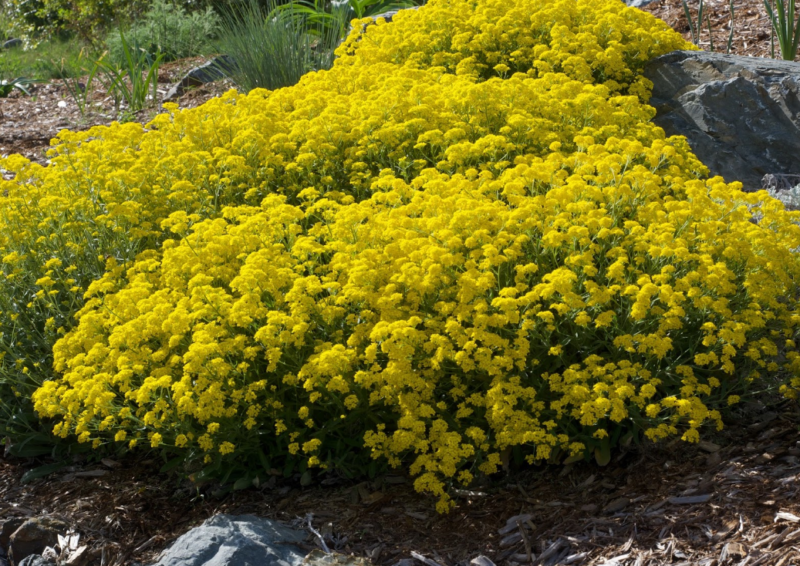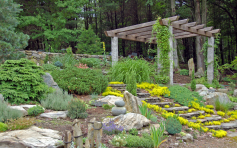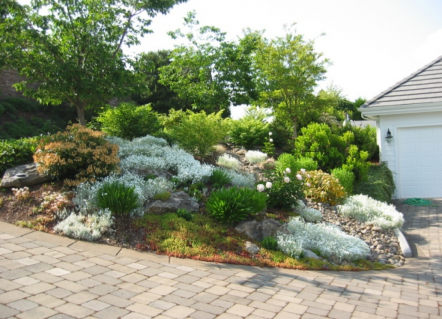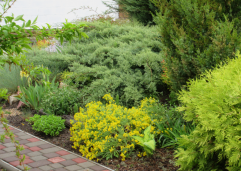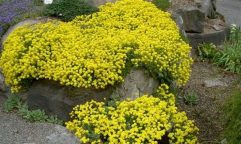In spring, alissum rocky blooms, forming an openwork carpet of bright yellow fragrant flowers. Growing it is an easy way to fill a large empty space of a spring flower bed or create a backdrop for other tall spring flowers.
Material Content:
General characteristics and description of varieties
This is a perennial plant from the cruciferous family, an excellent honey plant that attracts the first butterflies and bees. The flowers exude a pleasant, honey aroma. In decorative floriculture, alissum (alyssum) has been grown since the end of the 17th century, its homeland is Central Europe and Asia Minor.
The height of the flower does not exceed 25 cm, it has branched stems, lignified at the base. Small yellow flowers, gathered in dense brushes, bloom in spring, sometimes again at the end of summer.
Cultural forms differ slightly from the natural height of the bush, the structure and shades of the corollas:
- “Plenum” - plant height up to 30 cm, terry corollas, golden;
- "Compactum" - the height of aboveground shoots up to 20 cm;
- "Prokumbens" - creeping form, does not exceed 10 cm in height;
- "Citrinum" - lemon yellow flowers.
Variety "Doodle Nevil" has yellow-brown flowers, and "Variegat" has terry corollas.
Popular varieties with simple four-petal flowers:
- Alissum rocky “Golden placer” - small bushes with flowers of bright golden color in dense inflorescences;
- alissum rocky "yellow" - bushes up to 15 cm high, laden shoots, yellow simple flowers;
- Alissum "Golden Wave" - plants about a quarter meter high, 35 cm in diameter, golden yellow flowers;
- Alissum "Gold of the Incas" - stems erect, branched, corollas small, bright yellow.
The duration of spring flowering is about 40 days.
Growing plants from seeds
Grassy plants for open ground easily propagate by self-sowing, filling over time all the free space of the flowerbed. The seeds collected in autumn can be sown the next year in May directly into the ground: they germinate well. Such plants will bloom for 2 years of life.
When growing seedlings, alissum can be sown in March or early April, because the plant develops rapidly.
In good conditions, it blooms after emergence in about 1.5 months. In May, young plants are planted in open ground.
Before sowing, prepare loose, “fluffy” soil. Pour 3-4 cm of soil into the seedling box, level and moisten. It is advisable to spill the soil with a fungicide for the prevention of the black leg.
Outdoor planting and care
Alyssum is a very unpretentious and beautiful plant. In summer, it is practically not watered, due to drought resistance. It grows with a continuous carpet, preventing weeds from breaking through, so there is no need for weeding. But care is necessary to maintain a high decorative flower, especially in the first time after the emergence of seedlings or planting seedlings in open ground.
Bushes are watered in dry weather, weed, loosen the soil, fed with complex mineral agrochemicals for decorative flowering garden plants. It is necessary to observe a measure: with excessive watering, the plant is affected by fungal diseases, and dies.
In an open sunny place, alissum will bloom profusely.
Any soil suits the flower. Even on infertile soil, it develops perfectly, trying to capture all the free surrounding space. Seedlings grown from seeds are planted at the end of spring on a prepared flower bed, cleared of weeds. The plant does not like stagnation of water, so if the soil is heavy, clay, it is advisable to make drainage at the bottom of the holes.
The distance between the seedlings is up to you. Given the diameter of an adult bush, when tightly planted between the holes, 30 cm is left. From seedlings, the seedlings are transferred to the flower bed by the method of transshipment. Lightly compact the soil, water it well, and mulch with sawdust or bark. Alissum from seedlings will bloom in late summer or May of next year.
In early spring, alissum shoots can be trimmed a little so that the bushes grow more luxuriant. To increase decorativeness and longer flowering, wilted inflorescences are pruned if seeds are not needed. After flowering, the shoots must be shortened by 1/3 of the length.
Rock breeding Alyssum
Alissum can be propagated by seeds, cuttings or dividing the bush. The plant tolerates the transplant well, grows quickly. Any type of soil with neutral acidity and light structure is suitable for him.
The flower does not like stagnation of water, therefore, on heavy, clay soils, a drainage layer is necessarily made when planting.
The division of the bush is conveniently carried out in April, when planting large thickets of alissum. Delenki is placed at a distance of 30-40 cm from each other, they quickly grow in diameter. Cuttings are cut and root in the summer, in June or July. And growing from seeds is easiest to carry out in the open field in spring.
Pests and diseases
Under adverse weather conditions, insufficient or excessive watering and the presence of a source of infection, the plant may suffer from such diseases:
- brown rot of the root neck and roots;
- true and downy mildew;
- mosaics;
- wilting;
- jaundice astr.
Viral mosaic and jaundice of asters are not treated, the affected plants are dug up and burned. From mildew and root rot, fungicide treatments are effective, it is better to destroy heavily affected plants to prevent the spread of infection.
Of the pests on alissum, cabbage moths, cruciferous fleas, and turnip whites often feed.
For the fight, insecticides of systemic or contact action are used, in the summer you can treat the flowerbed “Fitoverm” several times.
If plants are severely affected by pests or fungal diseases, preparation for winter should include preventive spraying with insecticides and fungicides. Before this, shoots cut to 1/3 of the length are cleaned and burned.
Use in landscape design
Rock alissum goes well with red tulips and other bulbous plants blooming with it at the same time.
Experts recommend combining alyssum with low-growing groundcover plants:
- obrietta;
- phlox;
- harsh.
The alissum on stony hills looks effective when designing garden paths and flowerbed borders, in mixborders and when landscaping retaining walls. Since the plant is perennial, it does not need to be re-grown through seedlings and planted every year. This is very convenient for simple design of large flower beds and creating a beautiful garden that does not require careful maintenance.



